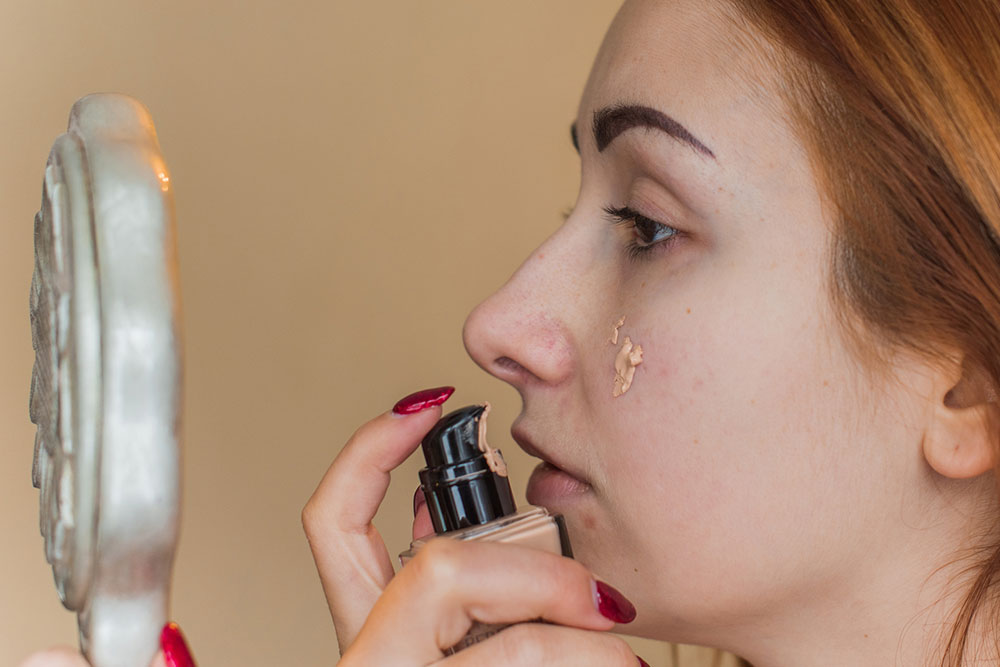Concealer is one of the must-have products for every makeup bag. When used correctly, it can cover up hyperpigmentation, dark circles, and acne scars. While one does not have to be a professional to learn how to apply concealer correctly, it certainly requires a few techniques to get things right. For this, it is crucial to learn about concealer mistakes that one needs to stop making. Read on to learn more:
Forgetting to prep the skin
The key to getting the best results from a concealer is to prep the skin well. Ensure to cleanse well to remove dirt, grime, dry skin cells, and oils from the face to open up the pores. Then, apply serums to nourish the skin, followed by a hydrating moisturizer. Finally, if it’s daytime, apply a broad-spectrum sunscreen to protect the skin from harmful UV rays. Let all these products be absorbed well into the skin for a few minutes. Then, apply the concealer. All of these steps will not only keep the skin healthy but will also ensure that the concealer spreads evenly and stays put for a longer time.
Using the wrong shade
Buying the right shade of concealer may seem like a simple task. After all, one just needs to match the shade with one’s skin tone. But this is not how it works. Picking the right shade of concealer needs a bit of work. Besides, just a single shade of concealer is never enough. This is because most people have a mix of multiple complexions on their faces. For instance, the area around the eyes might be darker than the area around the lips. Also, one needs to know their undertones, whether warm, cool, or neutral. This way, they can pick a concealer with a matching undertone for the best results.
Tip: For covering pigmentation and blemishes, a concealer that matches the foundation closely gives the best results. Meanwhile, under eyes can be brightened up using a concealer two shades lighter than the foundation.
Using the wrong texture of concealer
The texture of concealer is as important as the shade. For example, if the concealer has emollient pigment and is applied directly to a blemish, it may work as a highlighter under natural light. Instead of covering the spot, it will put more focus on it. In such situations, it helps to apply a base such as a sheer layer of foundation or a tinted moisturizer. Also, a concealer with a denser texture may work well in covering the blemish. On the other hand, a light and fluid concealer will be more effective in covering up dark circles under the eyes.
Using too much of the product
Earlier, concealer application trends put a lot of emphasis on putting too much of the product. For example, the method of applying concealers in huge triangle shapes under the eyes used to be quite popular. But for many, the results were less than flattering. Using too much of the concealer leads to too much creasing and caking. In fact, this technique accentuated fine lines and wrinkles instead of concealing them. Therefore, in the last few years, makeup professionals have adopted a more strategic concealer application. Now, concealer application depends on the look one wants and the formulation of the product. Here’s how to use a concealer for various looks:
- For under eyes: For this, less is more. Simply using three dots of concealer a little below the lash line is enough to cover up dark circles under the eyes.
- For a lifted look: Place a small amount of concealer under the outer corner of the eyes, in the inner corner, next to the lips, underneath the cheekbones, and around the nostril. Gently blend outwards using a damp beauty blender or a concealer brush.
- For a crease-free look: Apply a dab of light fluid concealer under the inner corner of the eyes. Slowly and gently blend outwards for a natural look.
Using the wrong tool
Sometimes, it is not just the concealer. It can also be the tool one uses to apply a product that is completely wrong. Based on the look one is working for, it is important to pick the right tool, whether it is a makeup sponge or a brush. For example, if full coverage is needed, using a damp beauty sponge will stretch out the coverage, resulting in a natural skin-like finish. While this is a good look to have, it is not what was needed. However, using a concealer brush can give the desired full coverage effect. Sometimes, for a sheer finish, using fingers to dab the product also works well.
Not setting the concealer
Not using a setting powder means letting the concealer crease and create a cakey effect. No matter how good the makeup application is, once the concealer starts to crease, it will ruin the entire look. Yet, many often forget to use the setting powder. As a result, the concealer moves into the fine lines, wrinkles, and open pores and starts to crease. So, never forget to set the concealer, especially when it has a fluid and liquid formulation. This will give a bright, smooth skin with a flawless finish, which will last for longer hours.



